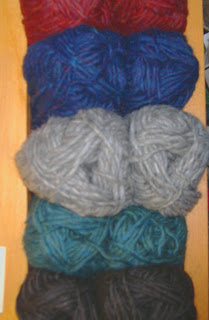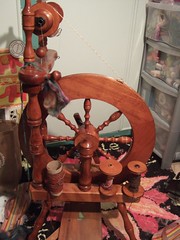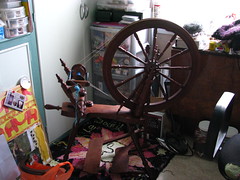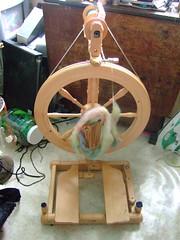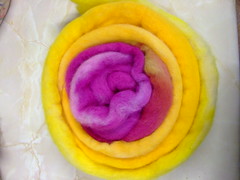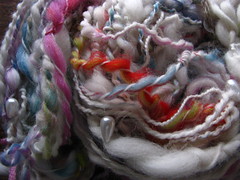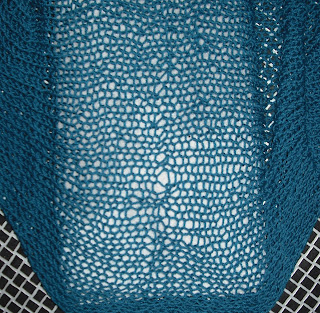Welcome back!
I'm sure you've been eargerly awaiting the next installment - as have I my friends and the time has now come.
Today I'll be blocking something a whole lot more spectacular. It is in fact a wedding shawl! Which means that it's white, white, white and more white and that's the reason that there isn't just one tutorial (it was easier to photograph the blue cardi) - I'll admit the photos aren't perfect but I never claimed to be a photographic genius!
I ought to talk a bit more about blocking first though. Blocking works on any fibre, and will certainly neaten up a man made or cotton yarn. However, the true benefits lie in blocking natural, animal fibres because these fibres have what we call 'memory'. Essentially, if you wet them and leave them they stay in that position. Lace reacts wondefully to a full, heavy blocking so mixing lace with natural fibres is like mixing chocolate with coffee or sunshine with the beach - it must be done. Any other fibre or any other technique and I'd probably go ahead and block by smoothing the item (see previous post) unless it's really out of shape and needs a good seeing to!
First, a photo to show you how atrocious this looked before it was blocked.
The first section is the same as before - soak the yarn in conditioner-ed warm water without stretching it, make sure it's well rinsed and not dripping wet. Take the knitting to the nearest unclothed and clean bed and collect together some sort of straight stick and a whole lot of rust-proof pins.
I'm at this point right now (don't hate me for the fact that for much of this series I completely forgot about the flash on my camera...):
Bit pathetic huh? Don't worry - it'll get better. I found the mid point of the longest side and pinned it squarely to the bed.
As I see it, the mid part of this shawl is a straight edge and the outside points curve upwards (described in the pattern as a chevron). On the longest edges of shawls some people like to thread a smooth yarn through every stitch and pin both ends of that down to make it properly straight. This would also work if you're blocking a square or rectangular garment. Because my edge isn't exactly straight (and I'm a glutton for punishment) I used a bunch (I mean about 60/70) pins every centimetre or so to create a smooth but curved edge.
Those of you that know me know I'm not a perfectionist. At this point I checked my lines by holding a long straight stick next to the shawl, if it was within half a centimetre I coped. Your mileage may vary and I won't hold it against you if you spend and hour or more neatening the whole length of the thing - you're a better person than I.
Once I'd pinned the edge satisfactorily I moved to the other side of the bed to pin out each of the points. I pinned one side and then it's twin on the other side:
Lace knitting needs to be stretched to open up the yarn overs so that it can look its best. Cabled, plain or colour worked knitting doesn't need this as much. Don't be afraid to stretch just a little more than you think is possible, especially if you need it to measure a certain length and it's just short. However, wet fibre can be fragile fibre and a broken thread at this point would be worse than poking your eye out with one of the blocking pins (probably...) so be careful and treat your yarn kindly. Carry on,
and on...
And eventually it'll look something like this:
Then really the only thing to do is to take 'artistic' photos whilst you drink coffee, pat yourself on the back and wait for the blasted thing to dry.
Here's the place for the before and after photos - unfortunately, being the hot-head that I am, the blue cardi was ripped back straight after blocking - sparing not a thought to it being the subject of a blog post - because I didn't like it. The blocking turned out beautifully - you'll have to take my word for that and one day I'll have a photo for you to peruse.
However - I do have finished photos of the shawl - which is the one I know you all want to see. Ta da:
You'll hopefully see that the stitches have been spread so that each motif has been fully realised. The points are also strong and true but the 'bounciness' of the hand knitting is still there. (Click on any of the photos to make them bigger).
Have a little scroll up and compare the size of this thing to how it was originally.
And that's it folks. It's not necessarily a comprehensive guide to blocking but it isn't some mystic rite of passage performed by witches or indeed a medieval method of torture - it's really quite simple and easy and maybe even a little bit magic. Give it a go on your next project and you won't look back.








